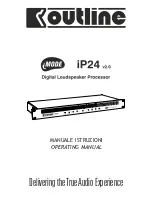Symphony DSP56724/DSP56725 Multi-Core Audio Processors, Rev. 0
20-8
Freescale Semiconductor
Chip Configuration Module
20.2.2.6
Pin Mux Control Register (PMC)
The PMC control register is shown in
Address
Y:FFFFE4
Access: User Read/Write
23
22
21
20
19
18
17
16
15
14
13
12
R
PKG1
PKG0
ERC3
ERC0
spdout1
_en
spdin1_
en
W
Reset
—
—
0
0
0
0
0
0
0
0
0
0
11
10
9
8
7
6
5
4
3
2
1
0
R
W
Reset
0
0
0
0
0
0
0
0
0
0
0
0
Figure 20-6. Pin Mux Control Register
Table 20-9. PMC Field Descriptions
Bit
Field
Description
23–22
PKG[1:0]
Read-only Chip Package Info
2’b10 DSP56725 80-pin QFP package
2’b01 Reserved
2’b11 DSP56724 144-pin QFP package
The reset value of these 2 bits is determined by the product’s package.
21–20
Reserved
Write 0 for future compatibility.
19
ERC3
S/PDIF Rx Clock Output via ESAI_3 HCKR Pin Select
0 No S/PDIF clock output via HCKR_3 pin
1 Select the S/PDIF Rx clock output via the HCKR_3 pin other than external clock when the
corresponding ESAI External clock control bit is set.
Note: HCKR_3 pin is not available on DSP56725 80-pin packages.
18
Reserved
17
Reserved
16
ERC0
S/PDIF Rx Clock Output via ESAI HCKR Pin Select
0 No S/PDIF clock output via HCKR pin
1 Select the S/PDIF Rx Clock output via the HCKR pin other than external clock when the
corresponding ESAI External clock control bit is set.
15
spdifout1_en SPDIFOUT1 Pin Mux Control
1 ESAI_2’s data pin SDO3/SDI2 is set to the SPDIFOUT1 function.
0 ESAI_2’s data pin SDO3/SDI2 is set to the ESAI_2 SDO3/SDI2 function.
Note: This bit only applies to DSP56725 80-pin packages.


















